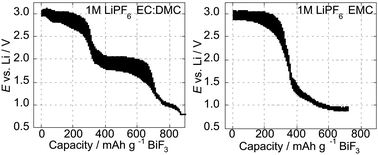Formation, dynamics, and implication of solid electrolyte interphase in high voltage reversible conversion fluoride nanocomposites
Abstract
Metal

* Corresponding authors
a
Energy Storage Research Group, Dept. of Materials Science & Engineering, Rutgers, The State University of New Jersey, 671 US Highway 1, North Brunswick, NJ, USA
E-mail:
agmitter@eden.rutgers.edu
b Laboratory of Physics & Astronomy, Rutgers, The State University of New Jersey, 136 Frelinghuysen Rd., Piscataway, NJ, USA
Metal

 Please wait while we load your content...
Something went wrong. Try again?
Please wait while we load your content...
Something went wrong. Try again?
A. J. Gmitter, F. Badway, S. Rangan, R. A. Bartynski, A. Halajko, N. Pereira and G. G. Amatucci, J. Mater. Chem., 2010, 20, 4149 DOI: 10.1039/B923908A
To request permission to reproduce material from this article, please go to the Copyright Clearance Center request page.
If you are an author contributing to an RSC publication, you do not need to request permission provided correct acknowledgement is given.
If you are the author of this article, you do not need to request permission to reproduce figures and diagrams provided correct acknowledgement is given. If you want to reproduce the whole article in a third-party publication (excluding your thesis/dissertation for which permission is not required) please go to the Copyright Clearance Center request page.
Read more about how to correctly acknowledge RSC content.
 Fetching data from CrossRef.
Fetching data from CrossRef.
This may take some time to load.
Loading related content
